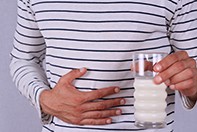Peer Reviewed
Gastroenterology clinic
Dealing with lactose intolerance
Abstract
The diagnosis of lactose intolerance should be considered in patients with ongoing gastrointestinal symptoms. This article provides some simple ways to diagnose and manage the condition.
Remember
- Lactose intolerance should be considered in a patient complaining of abdominal bloating, pain, flatulence and diarrhoea.
- Lactose intolerance is caused by a decreased level of the enzyme lactase, which is found in the small intestine. As a result, lactose is not broken down into glucose and galactose for absorption. Instead, it enters the colon where it is fermented into gases and fatty acids, which cause the symptoms.
- As an individual gets older or following gastroenteritis, lactose intolerance can develop spontaneously. Lactose intolerance can also occur in patients with coeliac disease.
- Lactose intolerance is very common in people of Asian or Mediterranean origin and in Ashkenazi Jewish populations. It is also present in most Indigenous Australians.
- A diagnosis of lactose intolerance is possible in patients complaining of irritable bowel symptoms, particularly if diarrhoea is more often experienced than constipation.
- Symptoms of lactose intolerance do not occur with the consumption of small volumes of milk. Generally, 200 mL of milk needs to be consumed for malabsorption to occur.
- The lactose content of milk is not related to the fat content, so low-fat milk can still be responsible for symptoms.
- Lactose intolerance is a separate issue to cows’ milk allergy, which causes a different set of nongastrointestinal symptoms.
Assessment
- Ask the patient to drink one litre of low-fat milk and record all symptoms. Low-fat milk should be used as the fat content of normal milk can cause the same sort of issues as lactose in some people. They then should avoid all milk, ice cream and high-lactose cheese for one week and keep a daily diary of their diet and symptoms, which can be assessed at the next consultation.
- Lactose intolerance can be confirmed with a hydrogen breath test, but this is rarely necessary.
- Lactase levels can be measured in biopsies of the small bowel taken at endoscopy; however, there is not a good correlation between lactase levels and symptoms.
- A glucose blood test after a lactose load is not reliable.
Advertisement
Management
- Small amounts of lactose should not cause symptoms in patients with lactose intolerance. Milk on cereal or in coffee or tea should be tolerated.
- The patient should avoid more than 200 mL of milk in a short period of time. Large amounts of ice cream, cream or soft white cheese (e.g. ricotta or cottage cheese) should be avoided.
- Hard yellow cheese, butter or yoghurt should not cause symptoms.
- Lactase enzyme supplements, available at pharmacies, can be added to milk to break down lactose into glucose and galactose, and allow absorption.
- Lactose-free milk (lactase-treated) is widely available in Australia, as are nonlactose-containing milks such as rice, almond and soy milks.
- Calcium intake should be monitored in patients on low-lactose diets, particularly women and taking into consideration whether they are pubescent, pregnant or menopausal. To reduce the risk of osteoporosis, calcium supplements should be considered if the patient’s intake is inadequate.
- If symptoms continue, consider a trial of a diet low in FODMAPs (Fermentable Oligosaccharides, Disaccharides, Monosaccharides And Polyols). The Monash University Low FODMAP app or web page (www.med.monash.edu/cecs/gastro/fodmap/) is a good place to begin the discussion with the patient. Referral to a dietitian may be necessary. As is always the case, if symptoms continue then the diagnosis should be reviewed.
Conclusion
- Lactose intolerance is a common cause of gastrointestinal symptoms and should always be considered before embarking on invasive investigations. Simple dietary manipulation may be all that is required.
COMPETING INTERESTS: None.
To continue reading unlock this article
Already a subscriber? Login here.

